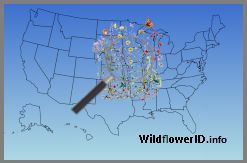Tips for IDing
One of the first things you can do, if you are new to IDing wildflowers, is to learn a few common plant terms. On this website, we like to describe the plants in laymen's terms, because most people don't know what a lot of botanical terms mean, but, if you are using a lot of reference books to help with your identification, you won't find very many laymen's terms in them. So, terms like the following may be very helpful to know:
- adventive: when a plant occurs in an area outside of its normal range
- alternate: a leaf arrangement where the leaves are not directly across from each other on the stem
- amplexicaule:
- annual: a plant that completes its life cycle in less than twelve months, which can be a single blooming season, or germination in winter, and then bloom the following season.
- basal:
- biennial: a plant that germinates and grows for a whole season, and then blooms in a following, second season before setting seed and dying.
- bract:
- calyx: an outside whorl of sepals, that together enclose the other parts of a flower, found outside (behind) the flower
- dehiscent: a seed pod that opens on its own when ripe
- ephemeral: a plant that appears for only a short time before then going dormant until its next bloom; usually of spring plants
- glabrous: smooth, without hairs
- glaucous: covered with a thin, light-colored waxy or powderiness
- indehiscent: a seed pod that does not open on its own
- inflorescence: the flowering portion of a plant
- involucre: a set of bracts directly under the flowering part of a plant
- opposite: a leaf arrangement where the leaves are in pairs directly across from each other on the stem
- perennial: a plant the lives and blooms for more than two years, often many more
- pubescent: covered with short, soft hairs
- sepal: a single segment of a calyx when it is divided into parts
- sessile:
- whorled: For tips on how to collect seeds, see our Seed Collecting Guide

